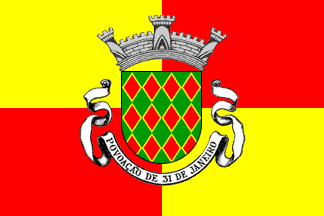
This page is part of © FOTW Flags Of The World website
Trinta-e-um de Janeiro (Angola)
Historical local flag
Last modified: 2019-08-06 by bruce berry
Keywords: trinta-e-um de janeiro | angola |
Links: FOTW homepage |
search |
disclaimer and copyright |
write us |
mirrors
 image by
António Martins-Tuválkin,
07 May 2016
See also:
image by
António Martins-Tuválkin,
07 May 2016
See also:
Background
Several municipalities of the Overseas Portuguese Empire which had adopted
Coats of Arms were subjected in the late 1930s and 1940s to the same kind of
homogenization that their metropolitan counterparts in
Portugal had been the subjected to during the previous decade at the hands
of the SHAAP/CHAAP (q.v.), this time with the help of the Overseas/Colonies’
Ministry. The start of the Colonial Wars in 1961 led to the creation of
several more, as granting symbols to settlements (and other similar accolades
such as the upgrading of their municipal upgrading) was one way for the
Portuguese Government to thank or compensate local populations and/or elites for
war damages.
One such case is Trinta-e-um de Janeiro (also known as 31 de Janeiro), a village
in the Uíge Province of Angola , that was targeted by UPA
attacks on 15 March 1961. It was granted local symbols - a Coat of Arms,
flag, and seal - by
Ministerial Edict
n.º 19410 published in the official journal Diário do
Governo : I série*226/1962* p.1309, on 01 October 1962. The Arms are
described as: Escudo de armas - Campo verde lisonjeado de doze peças de
vermelho debruadas a ouro. Coroa mural de prata de três torres. Listel branco
com os dizeres "31 de Janeiro) and the flag: Bandeira - Esquartelada de
amarelo e vermelho. Cordões e borlas de ouro
e vermelho.
António Martins-Tuválkin,
07 May 2016
Trinta-e-um de Janeiro - municipal flag
The flag follows the typical typical Portuguese communal
flag design, with the local coat of arms centered on a yellow and red
quartered background. The arms are Vert lozengy of twelve spots Gules fimbriated
Or. Mural crown Argent with three visible towers (commune rank) and white
scroll reading in black upper case letters "31 de Janeiro".
The banner should have golden and red tassels and cord.
tdj.gif) image by
António Martins-Tuválkin,
07 May 2016
image by
António Martins-Tuválkin,
07 May 2016
It is noteworthy the quality of the heraldic motifs used in this (and other
contemporary) coats of arms shows increased sophistication when compared with
those created in previous decades by the same body (and largely by
the same heralds).
Special treatment was given to this village as its symbols are granted
by a separate document,
Ministerial Edict n.º 19410, while the previous
legal text, Ministerial Edict n.º 19409 (idem, p.1308-1309), creates
and/or modifies 14 other such symbols, including eight in Angola. Of
these, none
is of a village and the rest are all for cities and towns.
This village is so small and unremarkable otherwise that I have had no
success so far in determining its current status, such as its
post-colonial name (the unusual name, spelled with digits, makes it harder to be
found). The alternative name, 31 de Janeiro means "January 31st" and refers
to an historic Portuguese date commemorating an aborted republican revolution in Oporto
in 1891.
tdj1.jpg) Image sent by Bruce Berry, 25 June 2016
Image sent by Bruce Berry, 25 June 2016
This coat of arms featured in a 1960s
postage stamp series,
being salmon-pink with a face value of 9$00. The stamp shows a slight difference
from the legal text, with the wording "Povoação de" ("Settlement of")
being absent.
António Martins-Tuválkin,
07 May 2016
tdj.gif) image by
António Martins-Tuválkin,
07 May 2016
image by
António Martins-Tuválkin,
07 May 2016

tdj1.jpg)